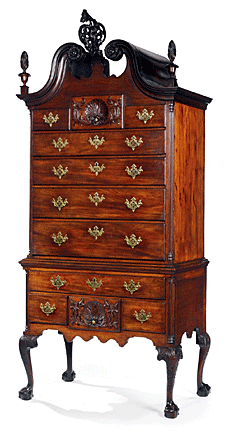 The woodwork of the 18th century has a
vocabulary all its own. Before spending thousands of dollars on a piece
of 18th-century furniture, you should understand the terms that describe
the details.
The woodwork of the 18th century has a
vocabulary all its own. Before spending thousands of dollars on a piece
of 18th-century furniture, you should understand the terms that describe
the details.
First, 18th-century furniture came in parts and was modular by design.
Back then there were no large trucks with lift gates to move large
pieces, and there were no elevators. Since large pieces had to be
carried by hand and had to fit in a wagon for transportation across town
or across the country, modular construction of larger pieces was almost
a requirement. Twentieth-century pieces, especially Colonial Revival
examples, while generally smaller in size, seldom have separate
components. The three parts of a secretary, for example, include the
crown, which extends to the top of the doors, the bookcase unit, and the
slant-front desk.
Most tall case pieces featured a “pediment.” This is an architectural
term that originally represented the triangular top that rises above a
portico or gable. It easily made the transition as a furniture element
in Italian furniture of the 16th century, moving to France in the 17th
century, and finally to England in the late 17th century and early 18th.
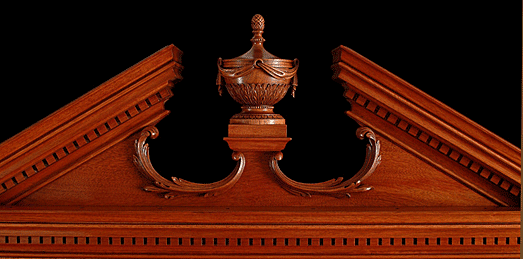
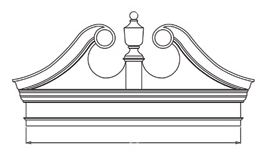 The "swan's-neck" portion of the pediment on a high boy, for instance,
refers to the flat "S" or cyma curves of the two rising pieces of the
crown. Classical triangular pediments meet in the center in an obtuse
point. “Broken” pediments leave an opening in the middle.
The "swan's-neck" portion of the pediment on a high boy, for instance,
refers to the flat "S" or cyma curves of the two rising pieces of the
crown. Classical triangular pediments meet in the center in an obtuse
point. “Broken” pediments leave an opening in the middle.
"Dentiled molded" describes the block-like decorative carving on the
underside of the pediment arches. This type of molding, another
classical element from Greek architecture, is called "dentil" because of
its resemblance to projecting, widely spaced teeth, even though the
spelling is different. Dentil molding on an arc is rare because of the
difficulty of executing a square block on a curved surface.
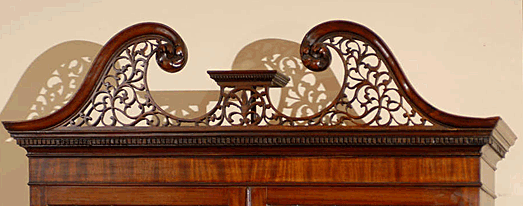
Sometimes cabinetmakers covered the circular faces of the pediment
curves with leaves, or they use other variations, such as spirals,
rosettes, and concentric circles.
Pierced latticework is the net-like feature that appears to be draped
from the pediment arches to the base of the central figure. Case pieces
from the Philadelphia area in the late 18th century often had pierced
latticework as part of their pediments.
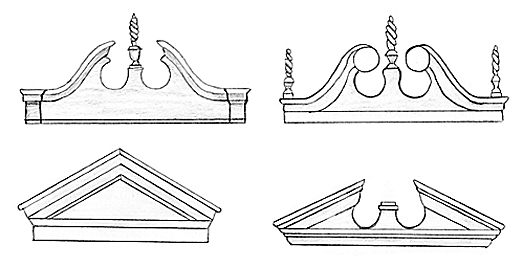
Some pieces of furniture feature a carved phoenix, a mythical bird
that’s supposed to live for 500 years and then rises, regenerated, from
the ashes of its funeral pyre. Unusually airy, asymmetrical carvings,
classical busts and cartouches rather than the standard urn, flame or
spiral finials are part of Philadelphia area pieces.
Below the pediment lies the cornice, the horizontal molding at the top
of a piece of furniture. On most pieces, the lines of the cornice are
uninterrupted from corner to corner. Some cornices additionally have
dentil molding as part of their design.
During the 18th century, cabinetmakers took their inspiration from
classical elements. The frieze is one of them.
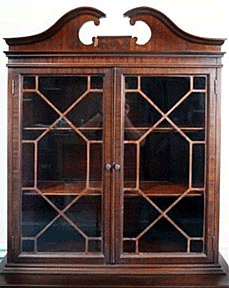 After the American Revolution, cabinetmakers liked to show their
patriotism by placing symbols of the new country in the design of their
furniture. Though visible symbols such as an eagle were common, some
chose to use more subtle symbols such as 13 panes of glass in the doors
of cabinets and secretaries to reflect the number of original Colonies.
After the American Revolution, cabinetmakers liked to show their
patriotism by placing symbols of the new country in the design of their
furniture. Though visible symbols such as an eagle were common, some
chose to use more subtle symbols such as 13 panes of glass in the doors
of cabinets and secretaries to reflect the number of original Colonies.
While 18th-century case pieces looked elegant from the outside,
cabinetmakers didn’t use expensive mahogany for parts that wouldn’t be
seen. Instead, they chose a less expensive wood, such as poplar, to make
the sides, backs and bottoms of drawers, as well as interior shelves.
Shelves were generally adjustable using fitted supports that rested in
notches in the front and rear of the cabinet. Candle slides—small
shelves that pulled out from the lower part of the case—were an
important accessory, and provided platforms for a tight source above the
work rather than placing it directly on the writing surface of a desk or
secretary.
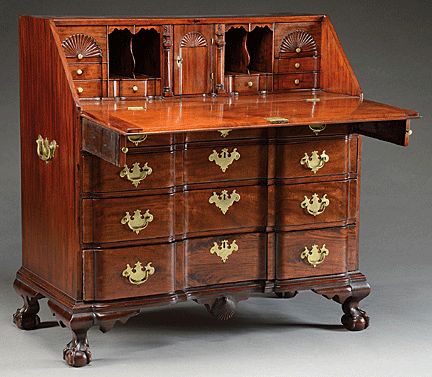 Freestanding desks and those on the bottom of secretaries had their own
unique features. Most desks had fitted interiors. Cabinetmakers often
assembled the interior structure as a separate unit consisting of a
frame and vertical dividers and then "fitted" this into the case of the
desk.
Freestanding desks and those on the bottom of secretaries had their own
unique features. Most desks had fitted interiors. Cabinetmakers often
assembled the interior structure as a separate unit consisting of a
frame and vertical dividers and then "fitted" this into the case of the
desk.
Letter slots or openings are traditionally called pigeonholes.
Cabinetmakers’ assistants cut the wood forming the shaped top of the
pigeonholes to resemble fabric that’s called a valance when draped over
the tester of a four-poster bed. These wooden valances over the
pigeonholes weren’t just for decoration. Sometimes they concealed small
secret drawers suspended in the top of the pigeonholes.
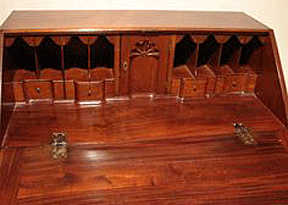 The small interior locking door often seen in middle of the interior of
the desk is known as a "prospect" door. In addition, desks often had
secret compartments in which to hide valuable family documents.
The small interior locking door often seen in middle of the interior of
the desk is known as a "prospect" door. In addition, desks often had
secret compartments in which to hide valuable family documents.
Fluted columns are another classical Greek architectural item, but
because there’s no place for round columns, cabinetmakers used quarter
columns as decoration on the fronts of chests, secretaries, and desks.
"Fluted" refers to the concave vertical channels in the column. The
ridges between the flutes are called "fillets." The opposite of fluted
is "reeded," a convex, rounded type of vertical line, sometimes used in
late 18th-century pieces.
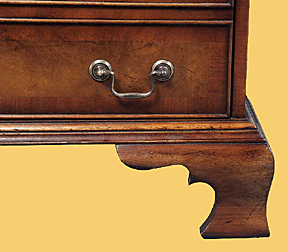 Ogee refers to the shaped vertical surface of the feet. The outline of
the brackets is another flat "S" shape or cyma curve with a tight radius
at the top of the bracket but with a longer looser radius toward the
bottom. This reflects the curve in the siding pediment of the crown. A
bracket foot is one that extends from the mitered corner of the base
molding of a case piece partially across the front and side forming a
right angle under the case.
Ogee refers to the shaped vertical surface of the feet. The outline of
the brackets is another flat "S" shape or cyma curve with a tight radius
at the top of the bracket but with a longer looser radius toward the
bottom. This reflects the curve in the siding pediment of the crown. A
bracket foot is one that extends from the mitered corner of the base
molding of a case piece partially across the front and side forming a
right angle under the case.
Because brass was the chief material used to make the hardware—drawer
pulls and door knobs and handles—for 18th-century pieces, they became
known as “brasses.”
< Back to Collecting Archives
Next
Article >
